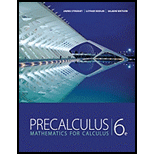
To calculate: To write the
Answer to Problem 67E
Polar form of complex numbers are
Product is
Quotient is
Explanation of Solution
Given information: Complex numbers are
Formula Used:
Complex number is a number that can be expressed in the form of
Polar form of the complex number is given as
Product of two complex numbers
Quotient of two complex numbers
Calculation:
Complex number are given as
Consider complex number:
Polar form of complex number is
Calculating the value of
Calculating the value of
Hence, complex number in polar form is
Consider complex number:
Polar form of complex number is
Calculating the value of
Calculating the value of
Hence, complex number in polar form is
Thus, complex numbers in polar form are:
Product of complex number is calculated as
Substituting the values, product is
Quotient of complex number is calculated as
Substituting the values, product is
Conclusion:
Hence, Product is
Quotient is
Chapter 8 Solutions
Precalculus: Mathematics for Calculus - 6th Edition
 Calculus: Early TranscendentalsCalculusISBN:9781285741550Author:James StewartPublisher:Cengage Learning
Calculus: Early TranscendentalsCalculusISBN:9781285741550Author:James StewartPublisher:Cengage Learning Thomas' Calculus (14th Edition)CalculusISBN:9780134438986Author:Joel R. Hass, Christopher E. Heil, Maurice D. WeirPublisher:PEARSON
Thomas' Calculus (14th Edition)CalculusISBN:9780134438986Author:Joel R. Hass, Christopher E. Heil, Maurice D. WeirPublisher:PEARSON Calculus: Early Transcendentals (3rd Edition)CalculusISBN:9780134763644Author:William L. Briggs, Lyle Cochran, Bernard Gillett, Eric SchulzPublisher:PEARSON
Calculus: Early Transcendentals (3rd Edition)CalculusISBN:9780134763644Author:William L. Briggs, Lyle Cochran, Bernard Gillett, Eric SchulzPublisher:PEARSON Calculus: Early TranscendentalsCalculusISBN:9781319050740Author:Jon Rogawski, Colin Adams, Robert FranzosaPublisher:W. H. Freeman
Calculus: Early TranscendentalsCalculusISBN:9781319050740Author:Jon Rogawski, Colin Adams, Robert FranzosaPublisher:W. H. Freeman
 Calculus: Early Transcendental FunctionsCalculusISBN:9781337552516Author:Ron Larson, Bruce H. EdwardsPublisher:Cengage Learning
Calculus: Early Transcendental FunctionsCalculusISBN:9781337552516Author:Ron Larson, Bruce H. EdwardsPublisher:Cengage Learning





